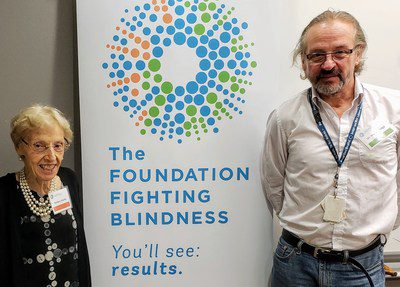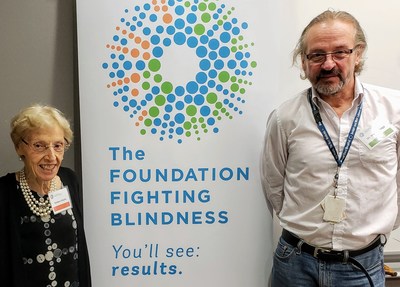TORONTO, Oct. 12, 2018 /PRNewswire/ — The Canadian scientist Dr. Andras Nagy, Senior Investigator at Mount Sinai’s Lunenfeld-Tanenbaum Research Institute, is announced today as the inaugural recipient of the Cedric Ritchie Fund to Cure Blindness, a new $1.5 million initiative made possible by the Foundation Fighting Blindness, Canada’s largest charitable funder of vision research.
The Foundation Fighting Blindness – Canada is proud to launch the Cedric Ritchie Fund to Cure Blindness on World Sight Day, a day that raises awareness about the 253 million people around the world who are living with a severe vision impairment or blindness.
A pioneer in the field of stem cell research, Dr. Nagy has been studying the intricacies of stem cells for thirty years and is world-renowned for discovering a method to create stem cells from other cells in the body, a breakthrough in regenerative medicine. “In many ways this is the culmination of decades of work,” said Sharon Colle, President and CEO of the organization awarding the grant, the Foundation Fighting Blindness – Canada. “Dr. Nagy is leveraging years of experience and research to develop a revolutionary approach to treating age-related macular degeneration (AMD), the leading cause of vision loss in people over the age of 50. Dr. Nagy aims to cure AMD by combining approaches in stem cell and gene therapy, two of the most promising therapeutic strategies in vision science.”
“Our hope,” continued Colle, “is that this grant will enable him to transition his approach out of the lab and into clinical trials, where it can be tested as an experimental treatment for people living with AMD. It’s a journey that will take five years, a very short period within the often-plodding timeframes of scientific discovery.” Clinical trials are an essential step in the development of potential treatments, and many scientists struggle to get that far. “Some refer to the gap between the lab and clinical trials as ‘the valley of death,'” said Colle. “It’s where excellent but poorly funded science goes to die. Considering what’s at stake in Dr. Nagy’s work, we couldn’t let that happen.”
Approximately 1.4 million Canadians are affected by AMD, and though treatment options exist for those with its most severe form, “wet-AMD,” these involve frequent ocular injections of “anti-VEGF” drugs. “VEGF” refers to “vascular endothelial growth factor,” an essential protein responsible for stimulating the growth of new blood vessels. In AMD, VEGF is overexpressed, leading to irregular blood vessel growth and, when left untreated, the leakage of blood into the eye—the “wet” in “wet-AMD.”
“We’re now able to genetically program stem cells to deliver anti-VEGF proteins on their own,” explained Dr. Nagy. “It’s a cutting-edge realization of the dream of regenerative medicine: rather than inject the protein into the patient’s eye, we program stem cells to do the work for us. An added benefit, and one with enormous potential, is that these stem cells could also replace the retinal cells that are damaged in advanced AMD, restoring vision for patients who have lost it.”
“This is an important stage,” continued Dr. Nagy, “in the decades-long quest to treat a disease that robs far too many of their sight. Laser surgery was the only option decades ago, then photodynamic therapy emerged as a viable means for removing abnormal blood vessels, and more recently anti-VEGF injections became the standard of care. But I really think that combining stem cells with gene therapy is the next step: it’s a new paradigm, a ‘one-shot’ therapy or cure that treats the condition while reversing vision loss, all without subjecting patients to regular discomfort and the barriers associating with repeated injections.”
“The advancement of this work would have been impossible without support from the Foundation Fighting Blindness,” said Dr. Nagy. “In Canada, funds earmarked for science are dwindling rapidly, so connecting individual donors to the best science possible has never been more essential.” The $1.5 million initiative is the result of an individual commitment from Barbara Ritchie, whose late husband, Cedric Ritchie, lived his final years without sight due to complications from AMD and glaucoma. Mr. Ritchie was a renowned entrepreneur and Canadian banker who rose from teller, then president and CEO, and finally to chairman of the Bank of Nova Scotia. “Cedric never let vision loss get in his way,” said Mrs. Ritchie, “and insisted on getting work done, regardless of the difficulty. I know that if he were here today, he’d want a similar principle applied to Canada’s vision science. He’d want the best science to be supported, and he’d want it maximized to impact as many people as possible.”
Contact Information: April Watts, Communications Manager, The Foundation Fighting Blindness – Canada, 1.800.461.3331 ext. 231, awatts@ffb.ca
Photo – https://mma.prnewswire.com/media/767801/Foundation_Fighting_Blindness.jpg





Facebook Comments